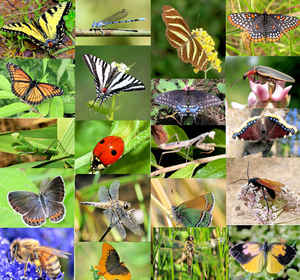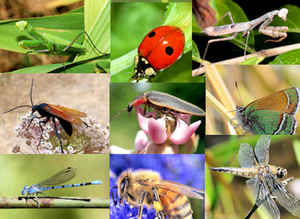
New Mexico Symbols
New Mexico State Insect
Tarantula Hawk Wasp

(Pepsis formosa)
Adopted in 1989.
The selection of the insect was prompted by a group of Edgewood, New Mexico elementary school children doing research on states which had adopted state insects. They selected three insects as candidates, and mailed ballots to all schools for a state wide election. The winner was the Tarantula Hawk Wasp, (Pepsis formosa.) As part of the class project, the entire class attended the legislative hearing in Santa Fe when the bill was introduced. The Tarantula Hawk Wasp was adopted by the 39th Legislature in 1989 as New Mexico State Insect.
New Mexico State Insect: Tarantula Hawk Wasp

Several species of the wasps known as "tarantula hawks" that build nests in the ground and provide their young with spiders for food inhabit the desert lands of the southwest. Pepsis formosa and Pepsis this be are probably the two most common. Wasps in the genus Hemipepsis are also known as "tarantula hawks." The species are difficult to distinguish. The Pepsis formosa specie is the spicie selected by the state. The majority of these wasps have metallic blue bodies, reddish antennae, and fiery red wings except for the outer margins and base.
Only a few animals, such as roadrunners, eat tarantula hawks. The wasps are "nectivorous," and they have been known to become "flight-challenged" after consuming fermented fruit.
Characteristics of the Tarantula Hawk Wasp
Tarantula hawk stings are considered to be the most painful of any North American insect. On a scale of one to four, Pepsis formosa was one of only two insects to rate a four. This compares with a one for a Solenopsis xyloni (desert fire ant), two for a Apis mellifera (honey bee) and three for a Dasymutilla klugii (velvet ant). Although painful, the Pepsis sting is not especially lethal. It rates a 38 on a lethal capacity scale. This compares with 5.9 for a Dasymutilla klugii, 54 for a Apis mellifera, and 200 for a Pogonomyrmex maricopa (a desert-dwelling seed-harvester ant).
Their means of reproduction is what gives them their name. Tarantula hawks are most active in the summer, during the day, although they avoid the
highest temperatures. Females give the wasps their common name. Like all members of this genus, they require a spider to serve as host for their larvae,
and in the case of the local species, tarantulas are the preferred nursery. This specie is unique in that, while only being approximately ? to 1? inches
in length, the females who are ready to lay eggs disturbs the web near a tarantulas burrow, and when the tarantula appears the wasp stings the spider
and injects venom.
The Tarantula Hawk is a parasitic wasp that uses the spider to feed its young in a macabre scene one expects in a horror story.
Instead of killing the tarantula, the venom only causes paralysis. The wasp then drags the tarantula to a burrow, stuffs it down the hole, and then
lays her eggs on top of the paralyzed spider. Several days later the eggs hatch, and the larvae feed on the still living tarantula. When the larvae
mature they metamorphose into adult wasps to complete the cycle.
Common Name: Tarantula Hawk, Tarantula Wasp, Tarantula Hawk Wasp
Latin Name: Hemipepsis spp.
Habitat: Dry hillsides and rolling arid plains
Range: California and Mexico
Tough Tarantula Hawks Are Wasps Well Worth Watching For
Durango Herald August 8, 2004
Leigh Gillette
The tarantual hawk wasp can be two inches long, and as thick as a pencil, making it one of the world's largest wasps.
(photo source: www.bugman123.com)
In 1989 the New Mexico State government designated the tarantula hawk wasp (Pepsis formosa) as the state insect. Sixth graders from Edgewood, New Mexico
spearheaded the nomination, backed by the voices of students across the Zia state.
Kids go for charismatic insects, and the beautiful, powerful, and deadly tarantula hawk fits the bill nicely. This handsome insect occupies southwestern
Colorado deserts too, and now's a great time to observe it.
The tarantula hawk (a member of the spider wasp family Pomilidae), is named for its hawk-like hunting prowess, and for its tarantula prey. This wasp
can be two inches long, and as thick as a pencil, making it one of the world's largest wasps. As the tarantula hawk flies, distinctively long legs
dangle beneath its metallic blue-black body and deep orange wings.
The tarantula hawk's coloration is a glaring public announcement: "Danger! Keep back!"This overt color scheme, termed "aposematic coloration,"warns
potential predators of the wasp's venom. The tarantula hawk's sting is considered the most painful of any North American insect. Fortunately for admirers,
the wasp is relatively docile, tending to sting only if handled, provoked, or if one happens to be a tarantula.
Interestingly, adult tarantula hawks eat only nectar, pollen, and fruit. The female wasps hunt tarantulas only to feed their young. The males, like
all wasps and kin, have no stinger and therefore do not hunt.
In early fall the females begin hunting for roaming or denning tarantulas. They fly low over open desert country, or run restlessly over the desert
floor, tapping the ground with their antennae in an attempt to pick up a tarantula's scent. Upon finding a tarantula in an underground den, the wasp
will either drum the ground in an attempt to entice the spider out, or enter the den to flush the occupant. The wasp must then overcome its enormous
prey by stinging the tarantula on the underside, where the legs join the body.
To do so, the wasp may seize the spider by the leg and flip it over, or wait for it to rear up defensively. Once injected, the wasp venom paralyzes
the spider, rather than killing it. The "dormant"spider is dragged back into its own burrow, or into a den dug by the wasp. Once underground,
the wasp lays a single egg on the tarantula. The wasp larva hatches atop an enormous, fresh food source. The larva slowly feeds on the living spider,
saving the still-functioning vital organs until last. When finished feeding, the larva spins a cocoon and pupates, emerging in spring as an adult tarantula
hawk.
In spring, territorial male tarantula hawks are seen posting watch on high points of ground or vegetation, waiting for the emergence of potential mates.
The kids were right! The tarantula hawk is an insect worth noticing. Head to the low country to catch a glimpse for yourself.
New Mexico Law
The law designating the tarantula hawk wasp as the official New Mexico state insect is found in the 2013 New Mexico Statutes, Article 3, Section 12-4-4 K.
Chapter 12 - Miscellaneous Public Affairs Matters
Article 3 - State Seal, Song and Symbols
Section 12-3-4 - State flower; state bird; state tree; state fish; state animal; state vegetables; state gem; state grass; state fossil; state cookie;
state insect; state question; state answer; state nickname; state butterfly; state reptile; state amphibian; state amphibian; state aircraft; state
historic railroad; state tie; state necklace.
Universal Citation: NM Stat § 12-3-4 (2013)
12-3-4. State flower; state bird; state tree; state fish; state animal; state vegetables; state gem; state grass; state fossil; state cookie; state
insect; state question; state answer; state nickname; state butterfly; state reptile; state amphibian; state aircraft; state historic railroad; state
tie; state necklace. (2011)
A. The yucca flower is adopted as the official flower of New Mexico.
B. The chaparral bird, commonly called roadrunner, is adopted as the official bird of New Mexico.
C. The nut pine or pinon tree, scientifically known as Pinus edulis, is adopted as the official tree of New Mexico.
D. The native New Mexico cutthroat trout is adopted as the official fish of New Mexico.
E. The native New Mexico black bear is adopted as the official animal of New Mexico.
F. The chile, the Spanish adaptation of the chilli, and the pinto bean, commonly known as the frijol, are adopted as the official vegetables of New
Mexico.
G. The turquoise is adopted as the official gem of New Mexico.
H. The blue grama grass, scientifically known as Bouteloua gracillis, is adopted as the official grass of New Mexico.
I. The coelophysis is adopted as the official fossil of New Mexico.
J. The bizcochito is adopted as the official cookie of New Mexico.
K. The tarantula hawk wasp, scientifically known as Pepsis formosa, is adopted as the official insect of New Mexico.
L. "Red or green?" is adopted as the official question of New Mexico.
M. "Red and green or Christmas" is adopted as the official answer of New Mexico.
N. "The Land of Enchantment" is adopted as the official nickname of New Mexico.
O. The Sandia hairstreak is adopted as the official butterfly of New Mexico.
P. The New Mexico whiptail lizard, scientifically known as Cnemidophorus neomexicanus, is adopted as the official reptile of New Mexico.
Q. The New Mexico spadefoot toad, scientifically known as Spea multiplicata, is adopted as the official amphibian of New Mexico.
R. The hot air balloon is adopted as the official aircraft of New Mexico.
S. The Cumbres and Toltec scenic railroad is adopted as the official historic railroad of New Mexico.
T. The bolo tie is adopted as the official tie of New Mexico.
U. The Native American squash blossom necklace is adopted as the official necklace of New Mexico.
History: Laws 1927, ch. 102, § 1; C.S. 1929, § 129-101; 1941 Comp., § 3-1303; Laws 1949, ch. 142, § 1; 1953 Comp., § 4-14-3;
Laws 1955, ch. 245, § 1; 1963, ch. 2, § 1; 1965, ch. 20, § 1; 1967, ch. 51, § 1; 1967, ch. 118, § 1; 1973, ch. 95, §
1; 1981, ch. 123, § 1; 1989, ch. 8, § 1; 1989, ch. 154, § 1; 1999, ch. 266, § 1; 1999, ch. 271, § 1; 2003, ch. 182, §
1; 2005, ch. 4, § 1; 2005, ch. 254, § 1; 2007, ch. 10, § 1; 2007, ch. 179, § 1; 2011, ch. 52, § 1.
Taxonomic Hierarchy: Tarantula Hawk Wasp
Kingdom: Animalia (Animals)
Phylum: Arthropoda (Arthropods)
Subphylum: Hexapoda (Hexapods)
Class: Insecta (Insects)
Order: Hymenoptera (Ants, Bees, Wasps and Sawflies)
No Taxon: (Aculeata - Ants, Bees and Stinging Wasps)
Superfamily: Pompiloidea (Spider Wasps, Velvet Ants and allies)
Family: Pompilidae (Spider Wasps)
Subfamily: Pepsinae
Tribe: Pepsini
Genus: Pepsis (Tarantula Hawks)
Species: formosa (Pepsis formosa)
Butterflies, and Bugs







